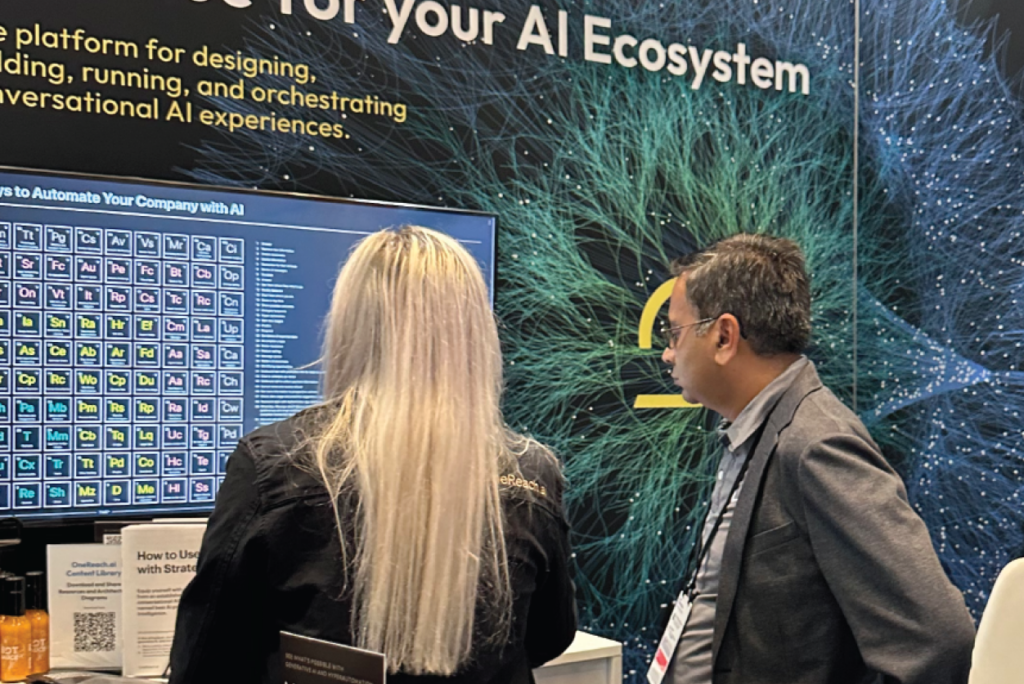“We’ve effectively created [..] the most advanced intelligent assistant in financial services. It’s completely trained on Morgan Stanley’s information. ” – Jeff McMillan
On a recent episode of Invisible Machines, OneReach.ai CEO and co-founder Robb Wilson, and Director of Creative Content Josh Tyson had a conversation with Jeff McMillan, Chief Analytics and Data Officer at Morgan Stanley. McMillan delved into the key insights and practical advice for creating a comprehensive AI assistant—highlighting the critical role of AI in reshaping business operations and emphasizing the need for leaders and doers to actively engage in its integration for sustained success.
In today’s rapidly evolving business landscape, AI adoption is a strategic imperative for companies who want to stay ahead of the curve and remain competitive. Many organizations rely on third-party consultants, many of which are still learning this technology themselves. By contrast, Morgan Stanley seized a rare opportunity to work directly with OpenAI, before the launch of ChatGPT. This relationship allowed Morgan Stanley to bypass common hurdles and begin building solutions faster, culminating in the successful launch of the AI Morgan Stanley Assistant.
Morgan Stanley’s Path of AI Implementation
Partnering with OpenAI, turned out to be a pivotal moment in Morgan Stanley’s journey. McMillan described the sort of “ChatGPT” moment he and his team had interacting with GPT-3 early in their burgeoning relationship. His group fed the LLM a speech made by Morgan Stanley’s co-president Andy Saperstein and began asking it real-time questions, comparing its responses to Saperstein’s. The AI’s answers were impressively superior, even acknowledged by the boss himself. This eye-opening experience prompted Morgan Stanley to explore how AI could revolutionize its operations.
Their approach was strategic and careful, focusing on three key criteria:
- creating value for financial advisors
- exploring opportunities in line with OpenAI’s expertise
- ensuring client data privacy.
McMillan’s aim was to use AI to harness Morgan Stanley’s wealth of knowledge—from research reports to financial guides on life events like marriage or divorce. This initiative was aimed at increasing the accessibility and utilization of their large information database, which was to improve their internal processes significantly.
An assistant that empowers every employee
Forging an AI assistant trained on the company’s internal documents represented a monumental leap forward for Morgan Stanley. Their advisors could now be as informed as possible by querying the institution’s legacy of information conversationally. Unlike the generic AI models flooding the marketplace, their assistant is finely tuned to the company’s vast amount of knowledge, ensuring every employee can access the smartest insights on any topic.
“We wound up with a use case to essentially take all the knowledge of Morgan Stanley, every research report, procedure, quick reference card, product information,” McMillan said. “… [the idea was] how we can make every employee as smart as the smartest person on any topic. And that’s where we are right now.” This approach, though advised against by industry experts like Gartner, represents a bold and strategic move that aligns with Morgan Stanley’s ambitious vision. It demonstrates the potential for specialized AI applications to revolutionize how information is accessed and utilized in highly regulated sectors like finance.
Leadership is Key to Successful AI Adoption
This implementation didn’t happen overnight and required a deep understanding of the technology, a commitment to continuous improvement, and an investment in educating both the leadership and the broader team.
McMillan cited the support and enthusiasm of Morgan Stanley’s co-president as instrumental. Their success sets an example that other companies follow—one where leadership support, combined with a talented team of engineers and designers, can make a significant difference in the progress and success of technology adoption.
Equally important was Morgan Stanley’s proactive approach to regulatory compliance. Recognizing the challenges of working in such a highly regulated industry as finance, the team first turned to the legal, compliance, and risk departments. Their collaboration ensured the responsible and controlled introduction of artificial intelligence, navigating the complexities of an industry that had never had a model for such innovation before.
Prototyping and design are no longer separate stages
In the new era of technology development, prototyping and design are no longer separate stages, but happen simultaneously. This approach is much more iterative and flexible than traditional methods. It allows for rapid design and real-time adjustments, fixing the gap between what the business wants and what technologists think it needs.
This change has revitalized the industry, injecting excitement and creativity into what was once an outdated process. As companies such as Morgan Stanley have demonstrated, when employees are engaged and empowered to creatively explore AI technologies, it ignites a spark in the organization, leading to innovative solutions and a vibrant, dynamic workplace culture. This evolution in technology promises not only more efficient and effective solutions but also more engaged and inspired employees. It also recasts an organization’s relationship to software. Rather than buying solutions from third parties, they can use the best tools in the marketplace to build and iterate on their own conversational software solutions.
This is an approach that Wilson and Tyson advocate for in their bestselling book on conversational AI, Age of Invisible Machines, which describes an approach to conversational AI that Wilson forged while building his own orchestration platform. The latest iteration of the OneReach.ai platform, GSX, is designed to let organizations build fleets of digital teammates called intelligent digital workers (IDWs). Using platforms like GSX and a unified strategy for AI puts organizations in position to control their own software destiny.
Conclusion
McMillan asserts that the key to accelerating AI implementation is widespread participation within the company. By decentralizing the process and involving various departments and external vendors, the adoption of AI becomes more dynamic and efficient. McMillan also emphasized the vital role of collaboration between business and IT departments.
“This technology … only allows more collaboration and more iteration, which is only going to result in better outcomes, full stop.”

